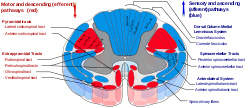Rubrospinal fasciculus
| Rubrospinal tract | |
|---|---|

Rubrospinal tract is labeled in red on the left of the diagram.
|
|

Schematic representation of the chief ganglionic categories (Rubrospinal tract not labeled, but red nucleus visible near center)
|
|
| Details | |
| Identifiers | |
| Latin | tractus rubrospinalis |
| NeuroLex ID | Rubrospinal tract |
| Dorlands /Elsevier |
t_15/12817153 |
| TA |
A14.1.02.220 A14.1.04.136 A14.1.05.332 A14.1.06.213 |
| FMA | 73995 |
|
Anatomical terminology
[]
|
|
The rubrospinal tract is a part of the nervous system. It is a part of the lateral indirect extra-pyramidal tract.
In the midbrain, it originates in the magnocellular red nucleus, crosses to the other side of the midbrain, and descends in the lateral part of the brainstem tegmentum.
In the spinal cord, it travels through the lateral funiculus of the spinal cord, coursing adjacent to the lateral corticospinal tract.
In humans, the rubrospinal tract is one of several major motor control pathways. It is smaller and has fewer axons than the corticospinal tract, suggesting that it is less important in motor control. It is one of the pathways for the mediation of voluntary movement. The tract is responsible for large muscle movement as well as fine motor control, and it terminates primarily in the cervical spinal cord, suggesting that it functions in upper limb but not in lower limb control. It primarily facilitates flexion in the upper extremities (see decorticate posture).
It is small and rudimentary in humans. In some other primates, however, experiments have shown that over time, the rubrospinal tract can assume almost all the duties of the corticospinal tract when the corticospinal tract is lesioned.
...
Wikipedia
